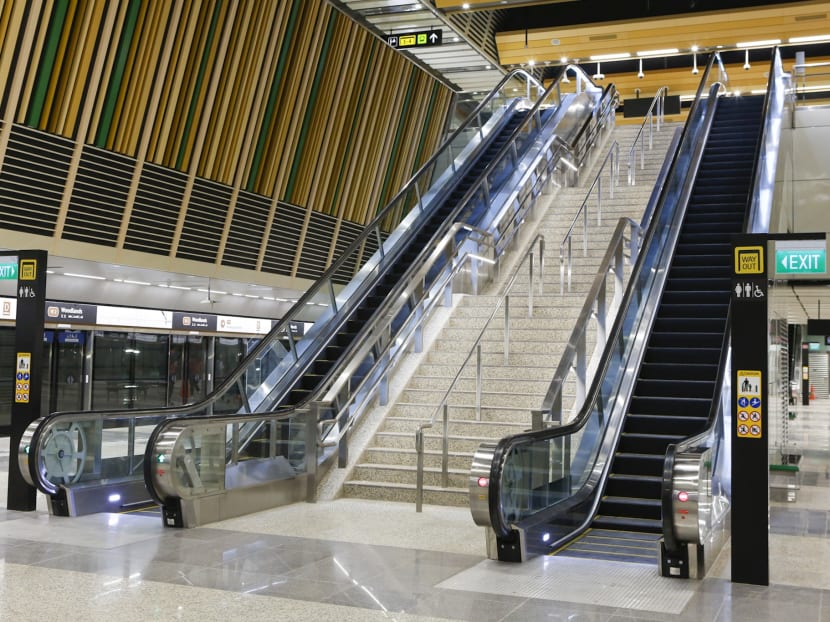11 more Thomson-East Coast stations to open in second half of 2022; more 'inclusive' changes for vulnerable commuters
SINGAPORE — Eleven more Thomson-East Coast Line (TEL) stations are expected to start service in the second half of this year, announced Transport Minister S Iswaran in Parliament on Wednesday (March 9).
SINGAPORE — Eleven more Thomson-East Coast Line stations are expected to start service in the second half of this year, Transport Minister S Iswaran in Parliament on Wednesday (March 9).
"This will connect residents in the north directly to many destinations in the city and significantly shorten travel times. Those who live or work near new stations like Great World, Maxwell and Shenton Way will have direct connections to the entire MRT network," he said during a debate on the ministry's budget.
Once the Thomson-East Coast Line line is fully completed, more than 240,000 households will be within a 10-minute walk from a station on the line.
MORE MRT STATIONS TO OPEN
Then in 2026, three stations will be added between HarbourFront and Marina Bay stations, closing the loop for the Circle Line.
After that, 24 stations on the Jurong Region Line are expected to be completed from 2027. The line serves the north-western part of Singapore, connecting towns such as Chua Chu Kang, Tengah and Jurong to Nanyang Technological University.
And from 2030, the Cross Island Line is projected to be completed in several stages.
The first stage will comprise stations from Aviation Park to Bright Hill, as well as the extension with three stations, namely Elias, Riviera and Punggol.
The second stage will extend further west, running through areas such as Turf City, Sunset Way, Clementi, West Coast and Jurong Lake District.
"A wider and denser network also strengthens resilience at the system level. When these lines are completed, we would have increased our rail network by 50 per cent to 360km," Mr Iswaran added.
INCLUSIVE PUBLIC TRANSPORT
Changes will also be made to Singapore’s public transport to make it more accessible to three groups of commuters — families with young children, deaf or hard-of-hearing commuters and those with dementia.
Mr Baey Yam Keng, Senior Parliamentary Secretary for Transport, said that these improvements aim to create a more inclusive commuting experience on the public transport system.
Baby care rooms will be provided at all Jurong Region Line and Cross Island Line stations, as well as at new bus interchanges for parents or caregivers travelling with babies and young children.
These rooms will provide a “private space” for nursing mothers and parents who need to attend to their babies, the Land Transport Authority (LTA) said in a press release.
At the moment, all interchange stations on the Thomson-East Coast Line and 60 per cent of bus interchanges are equipped with baby care rooms.
SUPPORT FOR DEAF, HARD-OF-HEARING COMMUTERS
To help commuters who are deaf or hard-of-hearing to communicate with public transport workers, the passenger service centres at all new MRT stations — starting with the Thomson-East Coast Line — will be equipped with hearing enhancement systems.
These systems enable sounds to be transmitted intelligibly to a person wearing hearing aids without the interference of background noise or reverberation, LTA said.
The passenger service centres at existing bus interchanges that are undergoing improvements, as well as those built from 2019 onwards, will also be equipped with the hearing enhancement systems.
Additionally, a “visual communication tool” developed by LTA in collaboration with The Singapore Association for the Deaf, the Building and Construction Authority and public transport operators will be rolled out at all MRT stations and bus interchanges by the end of this year.
This tool will show pictograms and text for common keywords to make communication easier between deaf or hard-of-hearing commuters and public transport staff members.
Mr Baey said: "Besides the deaf or hard-of-hearing community, this should also be useful to commuters who have other communication difficulties."
MORE DEMENTIA GO-TO-POINTS
LTA is also working with public transport operators to list all public transport nodes as Dementia Go-To-Points, which act as “safe return points” for people living with dementia, by the end of this year.
Public transport staff stationed at these points are trained to help to reunite such people with their caregivers.
"More than five million trips are made on public transport every day. We hope that the millions of eyes and ears can help to look out for people who show signs of dementia and are lost," Mr Baey said.
This initiative was first launched by the Ministry of Health and is supported by the Agency for Integrated Care (AIC) and community partners.
If members of the public spot people with dementia who are lost and need help, they can take them to the Go-To-Points where staff members will then assist them.
The points are also resource centres to provide information and useful resources on dementia and link those who need help with dementia-related services.
Currently, about 54 public transport nodes, including MRT and LRT stations, bus interchanges and integrated transport hubs, have been designated as Go-To-Points. The full list is available on AIC’s Dementia Friends mobile application. CNA
For more reports like this, visit cna.asia.







